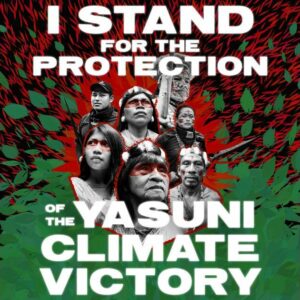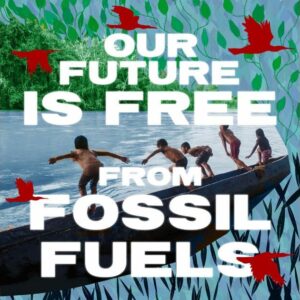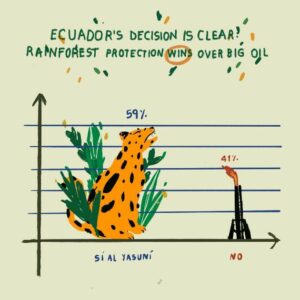What does it mean to secure land back? What does it mean to actually recover a territory, when it isn’t viewed as just a piece of land, but a living ecosystem, a map of memories and stories, an encounter of countless beings and species?
In November 2023, the Siekopai people won an enormous victory in the Ecuadorian courts, regaining formal ownership of their ancestral land of Pëkëya after over eighty years of struggle. But this crucial legal battle is only one dimension of the Siekopai’s movement to return home. Land back is also about reclaiming the narratives, identities and cultural practices associated with a territory. Over the last years, as part of that process of reclamation, Siekopai elders and young artists have worked together to bring multiple stories from Pëkëya to life.
The story of Ñakomasira, an animated short film co-directed by Siekopai filmmakers Ribaldo Piaguaje and Jimmy Piaguaje, is set in the heart of Pëkëya and recounts an old Siekopai tale about a legendary spiritual battle that led their ancestors to make a peace pact with the spirits of the water world. It’s a powerful reflection on territory, the spirits it holds, and how we can live in harmony with the many beings that surround us. We sat down with the film’s co-director, Ribaldo, to talk about the film, Siekopai storytelling, and the power of Indigenous art in the struggle to recover ancestral lands.
Ribaldo Piaguaje is a young Siekopai artist, working across many mediums, who started making films after participating in storytelling trainings with Amazon Frontlines’ sister organization, Ceibo Alliance. “In these workshops, I enjoyed learning about new formats and tools to tell stories”, Ribaldo recalls. “Our ancestors transmitted their stories orally, but now we have the opportunity to tell these same stories through other media, that can be shared to my people, and to others.”

Indigenous youth filmmaker, Ribaldo Piaguaje, sits around the fire in his people’s ancestral homeland, Pë’këya, to shoot a film about the COVID-19 pandemic
Eventually, Ribaldo started working on a film project in collaboration with fellow filmmaker Jimmy Piaguaje. As Ribaldo explains, the decision to make Ñakomasira, which takes place in the lagoons of the ancestral Siekopai heartland of Pë’këya, “came out of a desire to return to our territory, which has been in dispute between the Siekopai Nation and the Ecuadorian State. This territory is so important to us, it is one we continue to visit and connect with, and this story is about its meaning and its significance.”
Ribaldo and Jimmy started interviewing elders and documenting their recollections, eventually piecing together a common narrative of the age-old tale of Ñakomasira. Ribaldo and Jimmy initially wanted to make a documentary or film using real-time footage, but they quickly realized that it would be hard to go down that route if they wanted to tell an ancestral story. They eventually settled on using animation and decided to collaborate with Siekopai painter César Piaguaje, the son of the great spiritual leader Don Cesareo Piaguaje.

Siekopai artist César Piaguaje stands alongside paintings that were presented as part of the Siekopai’s lawsuit against the Ecuadorian government
“In our community we have a great painter – César – so we wanted to take advantage of his talent. The process to create the animation took approximately a year”, Ribaldo recalls. “César would start drawing, and we would scan his drawings to generate the animation. I organized the soundtrack for the animation, including the recreation of certain environments and spaces, such as when kids are playing and screaming. It was a beautiful experience of growth and learning too, because the realm of sound is a whole other world.”
This careful process of editing and recording culminated in a beautiful film, which was presented at a widely-attended community screening in 2019. As Ribaldo recalls, “The community was incredibly emotional when they watched the film; they had never seen anything like it. In our tradition, stories were always oral. Every person had to imagine them. With this animation, something with more presence appeared. It wasn’t just a story from our elders; it was the image of beings that had to be respected.”
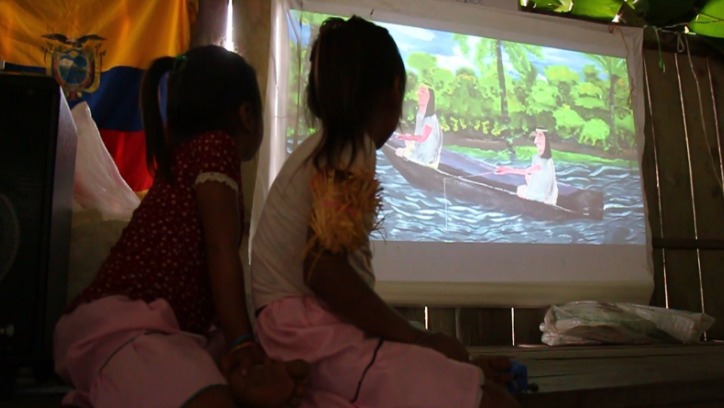
Siekopai children watch the animation “Ñakomasira” during a community screening
For many weeks afterwards, Ribaldo remembers how many of the children who had watched the film were scared about swimming in the river and lagoons nearby. But the fear eventually gave way to curiosity, and many requests from across the community for Ribaldo and Jimmy to make more animated films honoring Siekopai stories.
For Ribaldo, this is an encouraging sign, for a territory is also the stories it tells and carries. “Art and communication are important because they give life, they breathe life into our knowledge”, Ribaldo explains. “We stay alive by knowing our stories, by passing them on to children today; in doing so, we keep the territory and its knowledges alive. We are proud of our culture, and even if we are losing some of it, we are also keeping a lot of it alive.”
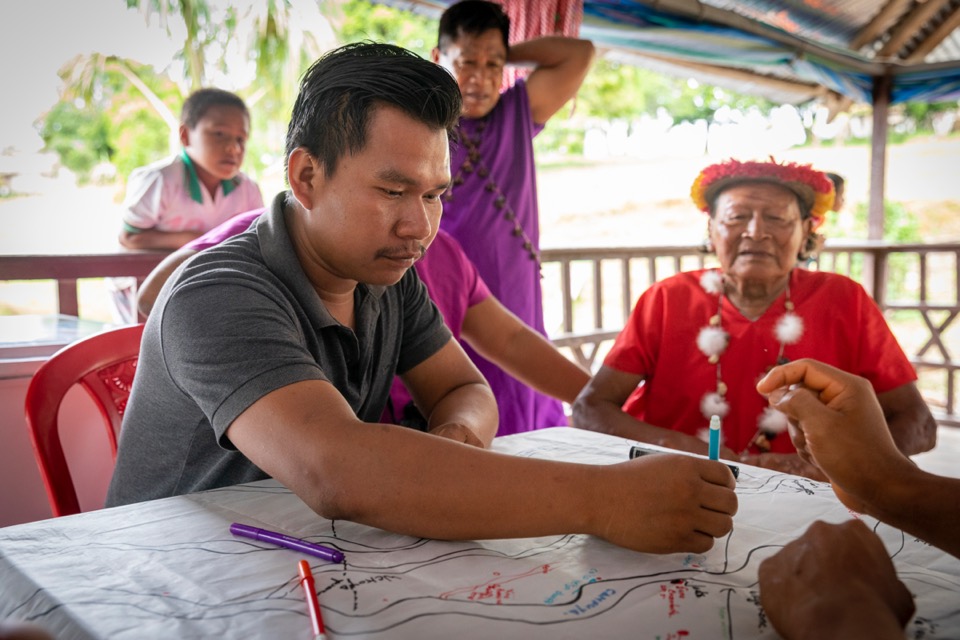
Siekopai filmmaker Ribaldo Piaguaje participates in his community’s mapping process to recover and reunite their ancestral territory in Ecuador and Peru
Ribaldo is one of many Indigenous youth across the Amazon turning to art and communications to safeguard the stories of their communities and territories. They are the first generation of storytellers using media like film, photography, and digital media to do this, directly contributing to their communities’ processes for cultural recovery and land protection. Challenging the status quo, where Western filmmakers and journalists have long dominated how Indigenous stories get told, these youth are reclaiming power to tell their own story and part of a wider move to fortify Indigenous self-governance, self determination, and autonomy.
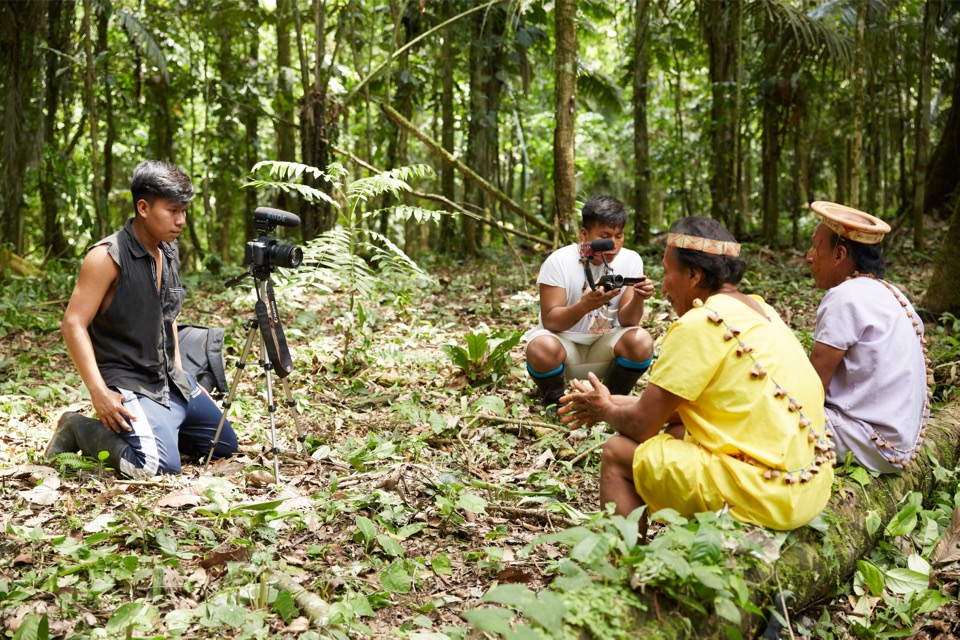
Siekopai filmmakers Ribaldo Piaguaje and Jimmy Piaguaje (right) collaborate to create a series of films about plant medicine knowledge with their elders
For Ribaldo, storytelling is key to the motivations behind efforts to secure land back. After all, an ancestral homeland, a healthy Indigenous territory, is a space where stories flow unimpeded between nature, ancestors, elders, youth, and future generations. As Ribaldo explains, “The Amazon is more than just a forest – it’s a living territory filled with different stories, knowledges, and ways of communicating that can be discovered. These ways of telling stories, of listening, of speaking, of living with nature and the world of the earth, need to be protected. Protecting them helps us remember there are many ways of living and being in the world: it’s not just mining, for example. Our ancestors, who were drinkers of yagé, knew how to balance and harmonize the environment. They knew how to build peace between different beings, to collectively live in the best way and share in the territory that always gives us life. We must remember and honor them.”

While the community has encouraged him to make more animations, Ribaldo is exploring multiple horizons. His next project is a documentary-fiction film exploring the loss and gain of culture as the world changes. “As a child living in the forest, I thought that Quito or Guayaquil was the end of the earth; now I’ve grown, and learned so much more. I want to explore how the loss of community knowledge is accelerating, while also new knowledge also emerges. In this process, many are returning to the ways in which we lived before. In my work, I want to leave a little grain of sand saying I am Siekopai, “I am from the land”.


